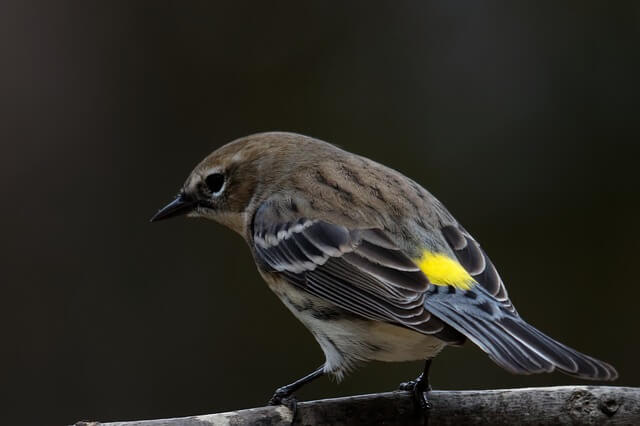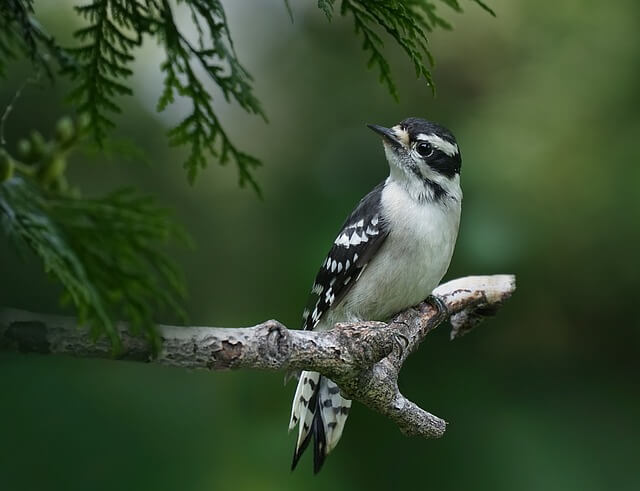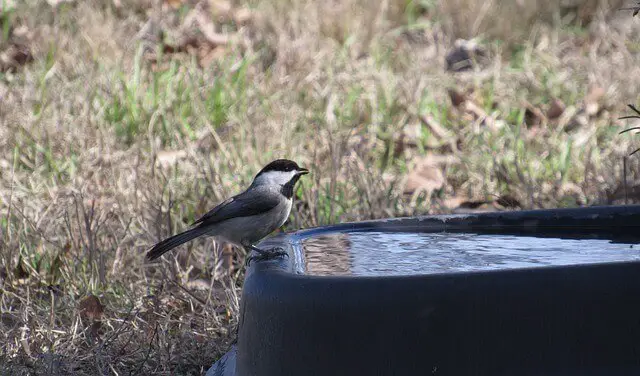Small Black And White Birds are fascinating creatures that can be found all over the world. From the adorable Black-capped Chickadee to the striking Black-and-White Warbler, these birds are a joy to behold.
In this article, we’ll take a closer look at some of the most common small black and white birds, their habitats, and interesting facts about them.
Whether you’re an avid birdwatcher or just appreciate the beauty of nature, this article will give you a new appreciation for these feathered friends.
So, are you ready to learn more about Small Black And White Birds? Keep reading to find out!
Table of Contents
Small Black And White Birds
Black and White Warbler

The elegant Black and White Warbler (Mniotilta varia) presents a captivating appearance with its contrasting colors. Dressed in striking black and white plumage, this charming songbird navigates its habitat with grace.
Found in North America’s lush woodlands and forests, it measures around 4.3-5.1 inches (11-13 cm) in length and weighs approximately 0.3-0.5 ounces (9-15 grams).
Its diet is predominantly insect-based, showcasing its remarkable foraging skills on tree trunks and branches.
With an average lifespan of 6–10 years, some of these warblers embark on impressive migratory journeys, gracing various regions with their presence.
While not of immediate concern, its conservation status warrants vigilance for the preservation of its woodland homes.
| Characteristic | Info |
|---|---|
| Scientific Name | Mniotilta varia |
| Wingspan | 6.3-7.9 in (16-20 cm) |
| Average Weight | 0.3-0.5 oz (8-15 g) |
| Habitat | Deciduous forests, wetlands |
| Diet | Insects, spiders |
| Lifespan | 6-10 years |
| Migratory | Yes |
| Conservation Status | Least Concern |
Yellow-rumped Warbler
The Yellow-rumped Warbler (Setophaga coronata) is a captivating avian marvel. With a dashing combination of yellow and gray plumage, it dazzles the eyes.
Its scientific name, Setophaga coronata, reflects its regal presence.
Boasting an average length of approximately 5.1 inches (13 cm) and a wingspan of around 7.5 inches (19 cm), it weighs about 0.4-0.6 ounces (11-17 grams).
This agile songbird finds solace in a variety of habitats, from coniferous forests to urban gardens. Its eclectic diet includes insects, berries, and nectar.
With a lifespan of up to 10 years, some populations migrate extensively, painting the skies with their journeys. Conservation efforts strive to safeguard its splendor and habitats.
| Characteristic | Info |
|---|---|
| Scientific Name | Setophaga coronata |
| Wingspan | 7.5-9.1 in (19-23 cm) |
| Average Weight | 0.4-0.6 oz (11-18 g) |
| Habitat | Forests, shrubby areas, coasts |
| Diet | Insects, berries |
| Lifespan | 5-10 years |
| Migratory | Yes |
| Conservation Status | Least Concern |
Downy Woodpecker
The Downy Woodpecker, a diminutive gem and one of North America’s most ubiquitous avians, graces a tapestry of forests and deciduous realms spanning from northern Maine to the vibrant landscapes of Mexico.
Measuring a mere 14 to 17 cm (5.5 to 7.0 in), its distinctive black and white plumage, adorned with a captivating scarlet crown, distinguishes it effortlessly.
With a penchant for wooded havens and suburban oases, these woodpeckers find their abode high within tree hollows, showcasing their adept tree-climbing prowess.
Unveiling their culinary artistry, they scour tree surfaces for insects, berries, and seeds, even unveiling concealed treasures like larvae and pupae from decaying wood.
Their preference for woodland realms over open spaces paints a portrait of their charming character, making them a delight to encounter.
| Characteristic | Info |
|---|---|
| Scientific Name | Picoides pubescens |
| Wingspan | 9.8-11.8 in (25-30 cm) |
| Average Weight | 0.7-1.0 oz (20-28 g) |
| Habitat | Forests, woodlands |
| Diet | Insects, seeds |
| Lifespan | 4-7 years |
| Migratory | No |
| Conservation Status | Least Concern |
Acorn Woodpecker

The captivating Acorn Woodpecker, scientific name Melanerpes formicivorus, is a symbol of nature’s ingenuity. With its striking appearance, this bird boasts a vibrant combination of black, white, and red plumage, captivating observers.
Residing primarily in western North America, including California and Central America, it thrives in diverse habitats such as woodlands and forests.
The Acorn Woodpecker’s lifestyle revolves around its unique dietary habits, as it meticulously stores acorns in granaries it creates in tree trunks.
With a wingspan of approximately 12-16 inches (30-41 cm) and a weight of around 3–5 ounces (85–140 grams), it navigates its surroundings with agile precision.
This fascinating species boasts a lifespan of about 9–15 years, showcasing its resilience in the wild. While not migratory, its resourceful behaviors are a testament to nature’s wonders.
The Acorn Woodpecker’s conservation status highlights the importance of preserving its habitat to ensure its continued enchantment graces our world.
| Characteristic | Info |
|---|---|
| Scientific Name | Melanerpes formicivorus |
| Wingspan | 13-17 in (33-43 cm) |
| Average Weight | 3-3.9 oz (85-111 g) |
| Habitat | Oak woodlands, forests |
| Diet | Acorns, insects, fruits |
| Lifespan | 9-15 years |
| Migratory | No |
| Conservation Status | Least Concern |
Black-capped Chickadee

The delightful Black-capped Chickadee (Poecile atricapillus) brings its own unique charm to the avian world. With its distinctive black cap and bib, white cheeks, and grayish body, this small passerine bird graces North American woodlands, parks, and gardens.
Measuring around 4.7-5.9 inches (12-15 cm) in length and weighing about 0.3-0.5 ounces (9–14 grams), it flits about in search of insects, seeds, and berries, showcasing its omnivorous diet.
Despite its diminutive size, it boasts an impressive lifespan of 2-3 years.
Known for its friendly demeanor, the Black-capped Chickadee is a non-migratory bird that braves the cold winters with its remarkable ability to lower its body temperature at night.
Its conservation status underscores the need for habitat preservation to ensure its continued presence.
| Characteristic | Info |
|---|---|
| Scientific Name | Poecile atricapillus |
| Wingspan | 5.9-6.7 in (15-17 cm) |
| Average Weight | 0.3-0.5 oz (9-15 g) |
| Habitat | Forests, gardens, parks |
| Diet | Insects, seeds |
| Lifespan | 2-3 years |
| Migratory | No |
| Conservation Status | Least Concern |
Carolina Chickadee
Meet the delightful Carolina Chickadee (Poecile carolinensis), a tiny wonder of nature. With its charming black cap and bib, soft gray feathers, and petite size, this songbird flourishes in the southeastern United States.
Sporting an average length of approximately 4.7 inches (12 cm) and a wingspan of about 6.3-8.3 inches (16-21 cm), it weighs a mere 0.3-0.5 ounces (9-14 grams).
This cheerful avian companion thrives in various habitats, including woodlands and suburban gardens. Its diet consists of insects, seeds, and berries, reflecting its adaptable and resourceful nature.
Despite its small stature, the Carolina Chickadee boasts a lifespan of 2–3 years. This endearing bird occasionally engages in short-distance migrations, showcasing its lively spirit.
While not of immediate conservation concern, safeguarding its habitats remains essential for the continued joy it brings to nature enthusiasts.
| Characteristic | Info |
|---|---|
| Scientific Name | Poecile carolinensis |
| Wingspan | 5.9-6.7 in (15-17 cm) |
| Average Weight | 0.3-0.5 oz (9-15 g) |
| Habitat | Woodlands, gardens |
| Diet | Insects, seeds |
| Lifespan | 2-3 years |
| Migratory | No |
| Conservation Status | Least Concern |
Black Phoebe
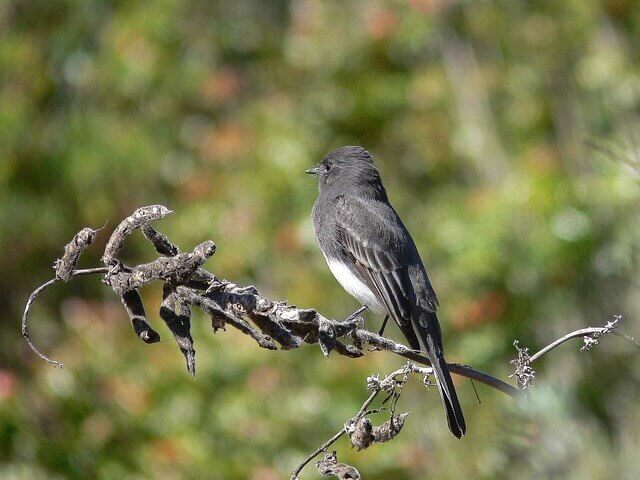
Meet the elegant Black Phoebe (Sayornis nigricans), a vision of grace and contrast. With obsidian plumage and a slender form, this passerine bird thrives near freshwater habitats across western North and Central America.
Its petite yet remarkable stature boasts an average length of 6.5 inches (16.5 cm) and a weight of about 19–24 grams.
A consummate insectivore, the Black Phoebe indulges in a diet primarily composed of flying insects captured in mid-air.
A resilient spirit, it graces the world with its presence for 3-5 years. While predominantly sedentary, some populations may venture on short migrations.
Despite its adaptability, the Black Phoebe faces habitat challenges in the ever-changing landscape.
| Scientific Name | Sayornis nigricans |
| Wingspan | 10.6-11.8 in (27-30 cm) |
| Average Weight | 0.6-0.7 oz (16-20 g) |
| Habitat | Riparian areas, coast |
| Diet | Insects, aquatic prey |
| Lifespan | 3-5 years |
| Migratory | No |
| Conservation Status | Least Concern |
White-breasted Nuthatch
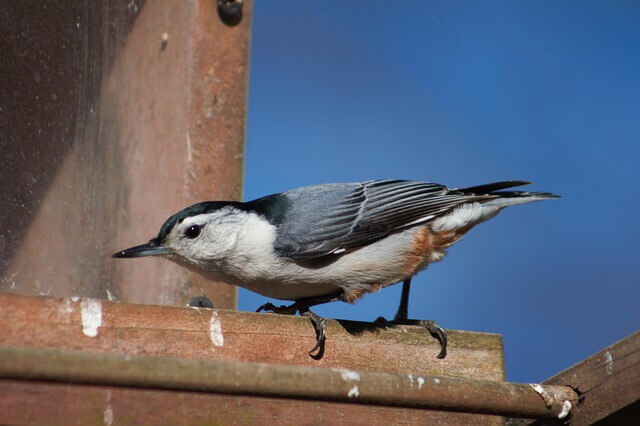
The captivating White-breasted Nuthatch (Sitta carolinensis) enchants with its distinctive features, including bluish-gray plumage and a striking black cap, as it navigates woodlands and forests of North America.
With an average length of about 5.9 inches (15 cm) and weighing around 0.7 ounces (20 grams), it forages deftly for insects, seeds, and nuts, exhibiting remarkable acrobatics on tree trunks and branches.
A testament to resilience, this nuthatch boasts a lifespan in the wild of up to 2–3 years, its year-round presence adding charm to its character and making it a delightful sight for nature enthusiasts.
While it remains non-migratory, the conservation of its habitat is of paramount importance to ensure its continued survival amidst changing landscapes.
Efforts to protect its woodland homes and maintain biodiversity will play a crucial role in safeguarding the White-breasted Nuthatch and its vibrant ecosystem.
| Characteristic | Info |
|---|---|
| Scientific Name | Sitta carolinensis |
| Wingspan | 7.5-8.7 in (19-22 cm) |
| Average Weight | 0.6-1.1 oz (18-32 g) |
| Habitat | Deciduous forests |
| Diet | Insects, nuts |
| Lifespan | 2-3 years |
| Migratory | No |
| Conservation Status | Least Concern |
Rose-breasted Grosbeak
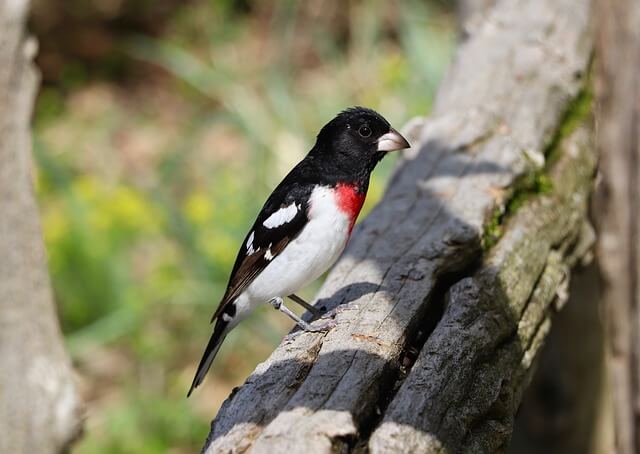
The captivating Rose-breasted Grosbeak (Pheucticus ludovicianus) dazzles with its vibrant plumage, including a rosy-red breast and bold black and white patterns, as it graces the woodlands and gardens of North America.
With an average length of approximately 7.1-8.7 inches (18-22 cm) and weighing around 1.4-1.9 ounces (40–55 grams), it feasts on a diverse diet of seeds, insects, and fruits.
A marvel of avian life, this grosbeak boasts a lifespan of up to 10 years, adding its melodic song to the symphony of the wild.
As a neotropical migrant, its awe-inspiring journeys between North and Central America fascinate birdwatchers and researchers alike.
Conservation efforts remain vital to protect its habitats and ensure the continued grace of the Rose-breasted Grosbeak in our skies.
| Characteristic | Info |
|---|---|
| Scientific Name | Pheucticus ludovicianus |
| Wingspan | 9.1-12.2 in (23-31 cm) |
| Average Weight | 1.0-1.5 oz (28-43 g) |
| Habitat | Forests, woodlands |
| Diet | Seeds, insects |
| Lifespan | 5-10 years |
| Migratory | Yes |
| Conservation Status | Least Concern |
Northern Flicker
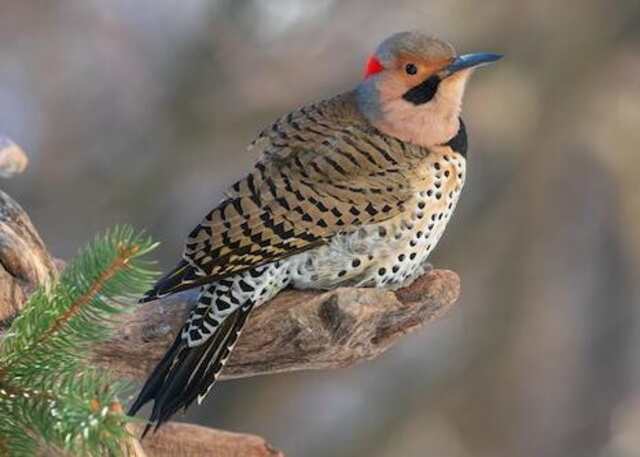
The charismatic Northern Flicker (Colaptes auratus) delights with its unique attributes, featuring a striking blend of brown and black plumage adorned with eye-catching spots.
Inhabiting diverse regions of North America, this woodpecker species thrives in woodlands, open areas, and urban environments.
With an average length of approximately 11–14 inches (28-36 cm) and a weight of about 3–5 ounces (85–140 grams), it employs its slightly curved bill to feast on insects, ants, and beetles.
Noteworthy for its rhythmic drumming on trees, the Northern Flicker adds its melodic calls to the symphony of nature.
A testament to adaptation, its lifespan of up to 6 years further adds to its allure.
While some populations migrate, others remain year-round, making conservation efforts vital to protect its habitats and ensure the vibrancy of our avian landscapes.
| Characteristic | Info |
|---|---|
| Scientific Name | Colaptes auratus |
| Wingspan | 16.5-20.1 in (42-51 cm) |
| Average Weight | 3.9-5.6 oz (110-160 g) |
| Habitat | Forests, open areas |
| Diet | Insects, fruits |
| Lifespan | 5-6 years |
| Migratory | Yes |
| Conservation Status | Least Concern |
Loggerhead Shrike
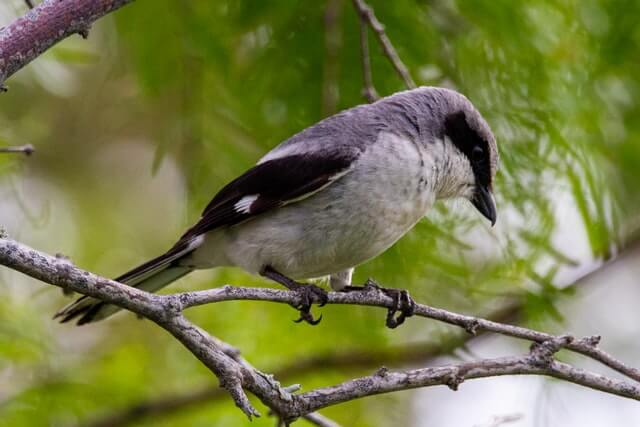
The Loggerhead Shrike (Lanius ludovicianus), distinguished by its bold black and white plumage with bluish-gray accents, commands attention as it graces the grasslands and open habitats of North America.
With an average length of approximately 9.4 inches (24 cm) and weighing around 2.3 ounces (65 grams), this adept predator balances on the delicate line between beauty and ferocity, preying on insects, small mammals, and even other birds, often impaling its catch on thorns.
Demonstrating impressive adaptability, this shrike boasts a lifespan of up to 3 years, standing as a testament to survival in diverse environments.
While not strongly migratory, its presence year-round enriches its environment, making it a captivating subject for birdwatchers and wildlife enthusiasts.
Ensuring the Loggerhead Shrike’s survival requires a collective commitment to safeguarding its habitat, a responsibility vital for preserving the dynamic balance of ecosystems it intricately participates in.
| Characteristic | Info |
|---|---|
| Scientific Name | Lanius ludovicianus |
| Wingspan | 9.1-10.2 in (23-26 cm) |
| Average Weight | 1.6-1.9 oz (45-55 g) |
| Habitat | Grasslands, shrublands |
| Diet | Insects, small vertebrates |
| Lifespan | 2-3 years |
| Migratory | Yes |
| Conservation Status | Least Concern |
Black-billed Magpie
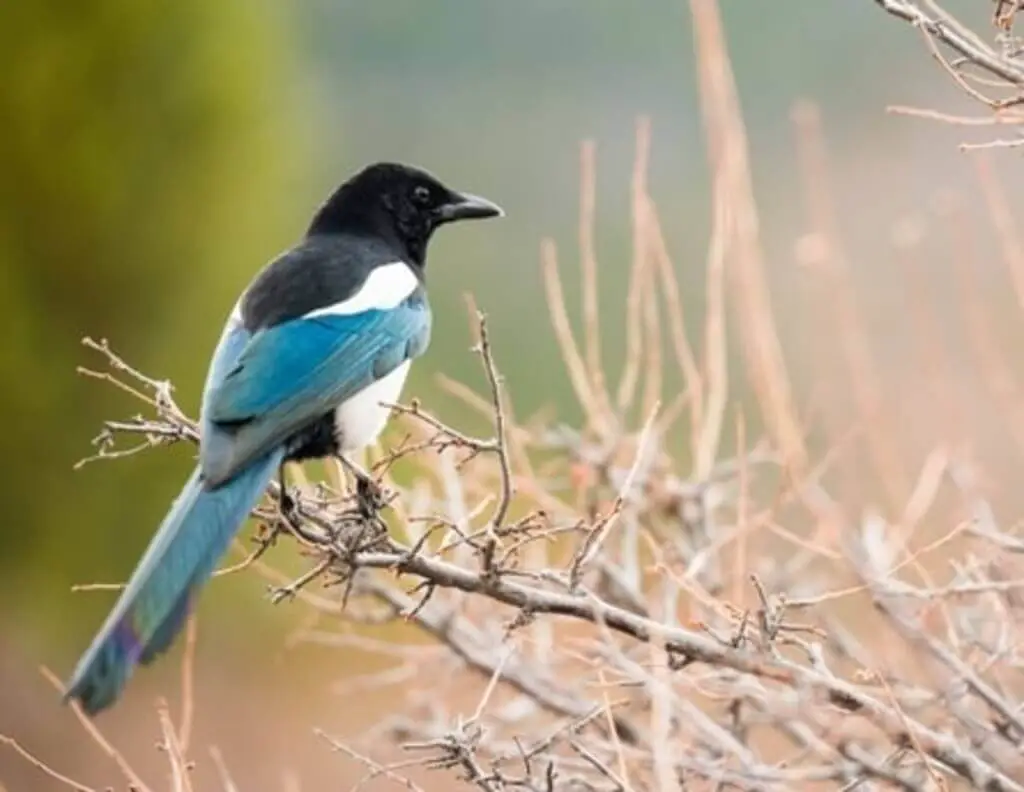
The Black-billed Magpie (Pica hudsonia) is a striking bird with black and white plumage, including black feathers on its head, neck, back, and wings, and white markings on its belly, shoulders, and primary feathers.
Found in western North America’s open habitats, this intelligent bird measures around 17-24 inches (43-61 cm) in length and weighs approximately 4–8 ounces (110-220 grams).
Known for its bold and curious personality, the Black-billed Magpie is a social bird that often forms large flocks.
With a lifespan of up to 9 years, this bird exhibits year-round residency while occasionally engaging in seasonal movements.
Conservation efforts must focus on preserving its habitat and food sources to ensure the continued vibrance of this captivating species amidst environmental changes.
| Characteristic | Info |
|---|---|
| Scientific Name | Pica hudsonia |
| Wingspan | 18-24 inches (46-61 cm) |
| Average Weight | 4-8 ounces (110-220 grams) |
| Habitat | Open habitats including forests and fields |
| Diet | Omnivorous, feeds on insects and seeds |
| Lifespan | 5-9 years |
| Migratory | Non-migratory, but may move seasonally |
| Conservation Status | Least Concern |


